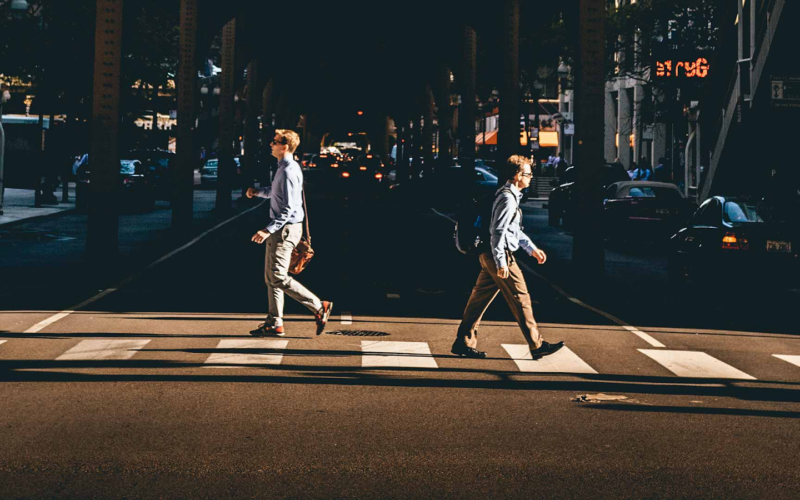Pedestrians enjoy several traffic rights, such as the right-of-way when crossing intersections. However, pedestrians must also adhere to traffic laws and avoid causing traffic accidents recklessly.
Therefore, pedestrians must practice several walking safety practices to protect themselves and others sharing the road.
For example, pedestrians must walk in designated areas, especially those specifically designed for them in construction zones.
It’s not always convenient to walk half a mile to reach the next intersection with a traffic light, as is the case in some areas of Los Angeles. However, most municipalities do not legally permit J-walking, and the practice can easily cause a traffic pile up.
The statistics show that 7,900 pedestrians died in vehicle-related collisions in 2020.
In addition, the National Highway Traffic Safety Association (NHTSA) also found that 80% of fatal accidents occurred in urban settings and open roads instead of intersections and crosswalks.
Let’s explore the definition of walking safety.
What is Walking Safety?
Walking safety is when pedestrians walk on public streets or trails without threat to their person or personal injuries.
Pedestrians play a crucial part in their safety. Although traffic laws protect them, walkers should avoid jumping out into intersections, especially during rush-hour traffic, without looking both ways first.
Even though the traffic signals that the walker can cross the intersection, the pedestrian must look both ways before stepping off the curb.
The NHTSA found that most pedestrian-involved accidents occur when visibility conditions worsen and on Saturdays.
Walkers involved in traffic accidents can bring suits against drivers. However, there are cases that personal injury attorneys will not take, namely, if the walker caused the accident. Read more here.
The following are seven walking safety tips.
1. Pick the Right Time
The type of walk dictates the best practices for walking individuals. Nonetheless, pedestrians need to pick the right time to walk whenever possible.
For example, it’s best to walk during daylight hours. Walkers who must walk in the evening or after the sun sets must practice additional caution.
Drivers must remain vigilant and spot nearby pedestrians. But pedestrians can also help drivers by increasing their visibility.
Whenever possible, stay safe while walking by picking the right time.
2. Pick the Best Routes
Next, pick the best routes. Most pedestrians know that drivers can become agitated waiting for them to cross the street. Nonetheless, drivers yield to walkers.
Pick walking routes that avoid congested traffic areas, construction zones, and areas without crosswalks.
Pedestrians who walk in their neighborhoods or on hiking trails should also pick the best routes to avoid hazards and dangerous obstacles.
3. Wear Appropriate Clothing
All individuals benefit from walking daily. Moreover, it’s a free exercise that only requires people to stand up and go.
Nonetheless, individuals should also wear appropriate clothing, including:
- Moisture wicking materials
- Comfortable shoes for happy feet and proper posture
- Brightly colored colors for maximum visibility
The proper clothing makes walks enjoyable and keeps walkers safe.
4. Invest in Gear
In addition to wearing appropriate clothing for walking, invest in walking gear. Some gear to consider includes:
- Smartphone
- Smartphone band
- Clip-on lights or reflective vest
Gear can make walks more effective by helping walkers count their steps, track their heart rates, and show them other health-related data.
Plus, the newest gear helps walkers stay safe.
5. Obey Traffic Laws
Traffic laws also apply to pedestrians. Although speed limits don’t apply to walkers, they should remain aware of how fast traffic around them might go.
Fluorescent yellow traffic signs warn drivers of pedestrians in the area and may direct walkers.
Therefore, pay attention to the traffic signs while enjoying leisure strolls or necessary walks.
6. Avoid Distracted Walking
Technology helps individuals make walks more enjoyable. However, tech can also lead to distracted walking.
Even walking with a partner or group can cause walkers to miss seeing oncoming traffic, stop signs, or changing traffic lights.
Thus, to remain safe during walks, avoid distracted walking, including listening to music loudly or becoming too involved in a conversation on the phone or with a partner.
7. Walk in Designated Areas
It’s essential to pick the right walking route to make strolling in designated areas easier.
Sometimes pedestrians cannot pick their routes and must work with what’s available. Thus, obey traffic laws and cross at intersections instead of J-walking.
Remember that twice as many pedestrian-involved traffic accidents occur on open roads than on crosswalks.
Conclusion
Pedestrians can enjoy strolls on residential, nature-focused, and busy streets. The key to walking safety is pedestrians remaining alert, just as drivers stay alert.

